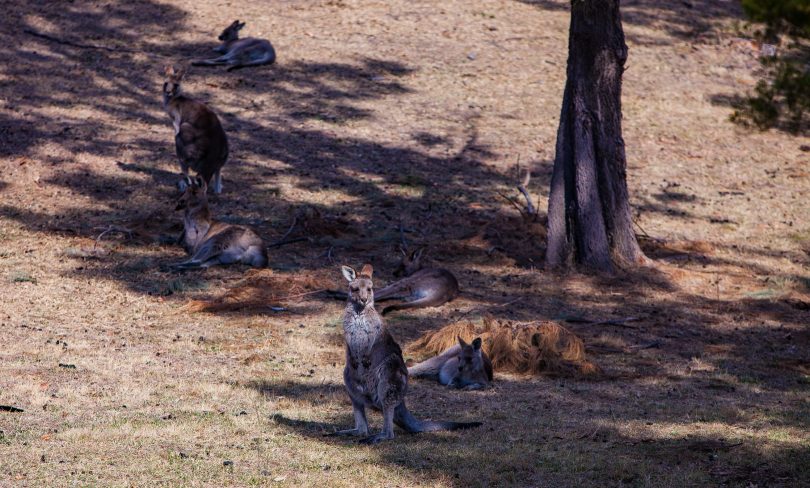
This year’s cull is the largest undertaken in the history of the program. Photo: George Tsotsos.
The ACT will conduct its largest-ever cull of Eastern Grey kangaroos, with 4076 roos to be killed in nature park reserves across the territory.
The 2019 ACT cull quota is more than the previous year when 3253 roos were culled across the territory and the program will also extend to over 14 sites.
This year’s cull is the largest undertaken in the history of the program in terms of numbers and sites to be targeted, which ACT Parks and Conservation Service director Daniel Iglesias said was due to grassy habitats decreasing across many local nature reserves, causing thousands of kangaroos to starve during the coming winter.
“Kangaroos are an integral part of the ecosystems around Canberra. The conservation cull protects biodiversity and maintains kangaroo populations at appropriate levels to minimise impacts on other plants and animals in critical grassland and woodland sites,” Mr Iglesias said.
“Given the lack of rain, if we don’t cull the kangaroos humanely now, many will starve to death during winter and the quality of the habitat for other species that rely on the ground level vegetation will deteriorate.

“Nobody likes culling kangaroos” – Daniel Iglesias. Photo: Goerge Tsotsos.
“Our ecologists have used the best current scientific knowledge to analyse the status of each reserve’s population, the amount and type of vegetation, rainfall and other relevant factors to determine the numbers to be culled to support conservation outcomes.
“While nobody likes culling kangaroos, it is currently the most humane method of population management available to the ACT Government as a responsible land manager.”
The ANU’s Professor George Wilson, a nationally recognised expert on wildlife ecology management, has backed the plan and says that ACT Parks and Conservation research on managing urban kangaroo populations is the best in Australia.
“The scientists have done marvellous work in conjunction with the two universities in assessing an appropriate density in different reserves,” he says. “They have the best information in the country on what density of kangaroos is appropriate alongside other biodiversity objectives and they must manage to that density. Otherwise, they’re culpable for biodiversity loss.”
Professor Wilson says lack of natural predation has caused an exponential increase in the local kangaroo population. “The kangaroos have this wonderful environment with lots of green grass and protection. That’s not a problem when population is low, but once they get into the tens of thousands, a natural increase of 15 per cent or more each year has a huge impact on the environment.”
After studying and working with kangaroos for more than 50 years, Professor Wilson says he knows (and likes) the marsupials more than most people. “I do everything I can to maximise their welfare. That doesn’t involve allowing them to starve to death or be hit by cars, which are now their major form of predation in Canberra.
“We love to see kangaroos on Red Hill, but we need to know what population Red Hill can actually support. Is it 50, 150, or is it 550?”
Professor Wilson calls the international “compassionate conservation” movement “bad science and bad animal welfare” that allows animals to starve and be run over rather than managing their populations. He believes that a professional shot to the head is “far and away” the most effective control measure.
“ACT Parks and Conservation have a responsibility to biodiversity more widely. They’d abrogate that responsibility if they don’t manage kangaroo populations effectively.”
ACT Parks and Conservation Service will place warning signs and surveillance cameras at all entry points to the reserves where culls are taking place and staff will patrol the reserves during culling operations.
Callum Brae Nature Reserve, Crace Nature Reserve, East Jerrabomberra Grasslands, West Jerrabomberra Grasslands, Goorooyarroo Nature Reserve, Gungaderra Nature Reserve, Kama Nature Reserve, Mulligans Flat Nature Reserve, Mulanggari Grasslands, the Pinnacle Nature Reserve, Mount Mugga Mugga Nature Reserve, Isaacs Ridge Nature Reserve, Mount Majura Nature Reserve and Mount Ainslie Nature Reserve will be closed from Tuesday 7 May, from late afternoon until early morning each day.
The sites are to be re-opened from 26 July or earlier if the program is completed sooner.
Original Article published by Lachlan Roberts on The RiotACT.







